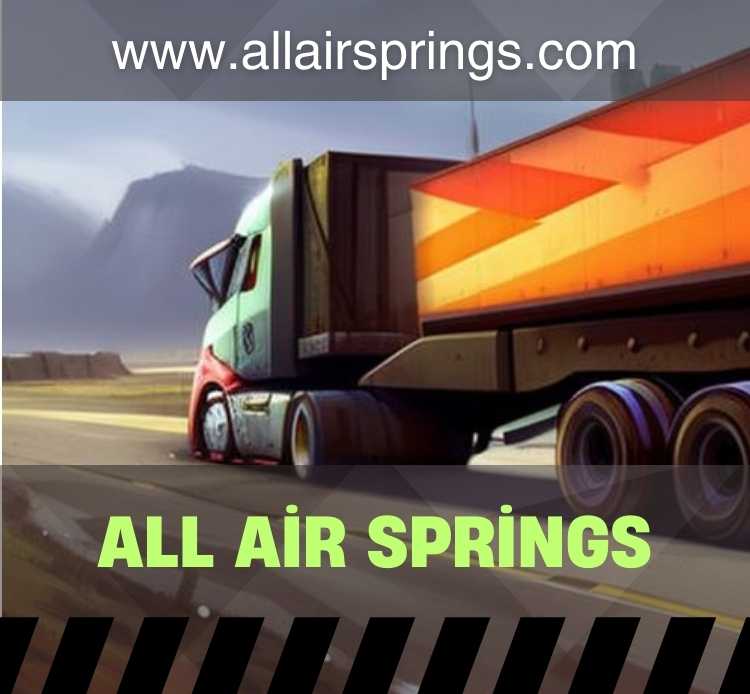
Air Springs: A Comprehensive Guide to Understanding, Benefits, Maintenance, and Troubleshooting
Introduction to Air Springs
Air Springs are a type of mechanical spring that uses compressed air as the primary source of elasticity. They are used in a variety of applications, including heavy-duty vehicles, industrial machinery, and even amusement park rides.
There are several different types of Air Springs, including Rolling Lobe, Convoluted, and Sleeve, each with their unique characteristics and benefits. Air Springs offer several advantages over traditional metal springs, such as improved ride comfort and vehicle stability, increased load-carrying capacity, reduced noise and vibration, and longer lifespan and lower maintenance costs.
In this chapter, we will provide an introduction to Air Springs and their various applications. We will discuss the different types of Air Springs, their construction and mechanics, and the factors to consider when selecting Air Springs. By the end of this chapter, you will have a better understanding of Air Springs and their benefits in various industries.
How Air Springs Work
Air Springs work by using compressed air to provide elasticity and absorb shock. They are typically made up of rubber and fabric materials and contain a sealed chamber that is filled with compressed air. As the load is applied to the Air Spring, the compressed air is displaced, causing the spring to expand and absorb the shock.
Compared to traditional metal springs, Air Springs offer several benefits. They provide a smoother and more comfortable ride, reduce vibration and noise, and offer greater load-carrying capacity. They are also more durable and require less maintenance than traditional metal springs.
In this chapter, we will dive deeper into how Air Springs work. We will discuss the mechanics of Air Springs, how they provide elasticity and absorb shock, and the benefits of Air Springs over traditional metal springs. We will also explore the factors to consider when selecting Air Springs, such as load capacity and inflation pressure. By the end of this chapter, you will have a better understanding of how Air Springs work and their advantages in various applications.
Advantages of Air Springs
Air Springs offer several advantages over traditional metal springs, making them a popular choice in a variety of applications. One of the primary advantages of Air Springs is their ability to provide a smoother and more comfortable ride. They absorb shock and vibration better than metal springs, resulting in a more stable and comfortable ride.
Another advantage of Air Springs is their increased load-carrying capacity. Because Air Springs can be inflated to a specific pressure, they can support heavier loads than traditional metal springs. This makes them a popular choice for heavy-duty vehicles and industrial machinery.
Air Springs also offer reduced noise and vibration, making them ideal for applications where noise reduction is important. They are also more durable and require less maintenance than traditional metal springs, resulting in lower operating costs over time.
In this chapter, we will explore the advantages of Air Springs in more detail. We will discuss the improved ride comfort and vehicle stability they provide, their increased load-carrying capacity, and their ability to reduce noise and vibration. We will also discuss the longer lifespan and lower maintenance costs associated with Air Springs. By the end of this chapter, you will have a better understanding of the advantages of Air Springs and their various applications.
Maintenance and Troubleshooting Tips for Air Springs
Proper maintenance is essential for ensuring optimal performance and longevity of Air Springs. Regular inspection, inflation, and deflation are necessary to keep Air Springs functioning correctly. In this chapter, we will provide some maintenance and troubleshooting tips to help you keep your Air Springs in top condition.
One of the most critical aspects of Air Spring maintenance is proper inflation and deflation. Overinflated Air Springs can cause damage to the system, while underinflated Air Springs can result in poor performance and reduced load-carrying capacity. Regular inspection and monitoring of inflation levels are crucial to ensure that your Air Springs are functioning correctly.
Additionally, it’s essential to inspect Air Springs regularly for signs of wear and tear, such as cracks, leaks, or other damage. Any worn or damaged parts should be replaced promptly to prevent further damage to the system.
In this chapter, we will provide tips for proper inflation and deflation techniques, inspection and replacement of worn-out parts, and common problems with Air Springs and how to fix them. By the end of this chapter, you will have a better understanding of how to maintain and troubleshoot your Air Springs to keep them functioning correctly.
Applications of Air Springs in Various Industries
Air Springs have a wide range of applications in various industries, from heavy-duty vehicles to industrial machinery and even amusement park rides. In this chapter, we will explore some of the applications of Air Springs in different industries.
One of the most common applications of Air Springs is in heavy-duty vehicles, such as trucks and buses. Air Springs provide a smoother and more comfortable ride for passengers, reduce vibration and noise, and offer increased load-carrying capacity for cargo and equipment.
Air Springs are also used in industrial machinery, such as presses, stamping machines, and injection molding machines. They help to reduce vibration and noise, improve stability and precision, and protect the machinery from shock and impact.
In addition to these applications, Air Springs are also used in construction equipment, agricultural machinery, and even in furniture and seating. They provide benefits such as improved ride comfort, increased load-carrying capacity, and reduced noise and vibration.
In this chapter, we will discuss the applications of Air Springs in various industries, including heavy-duty vehicles, industrial machinery, construction equipment, and more. By the end of this chapter, you will have a better understanding of the versatility of Air Springs and their role in various applications.
For detailed information, you can contact us at torqueusa.com.


